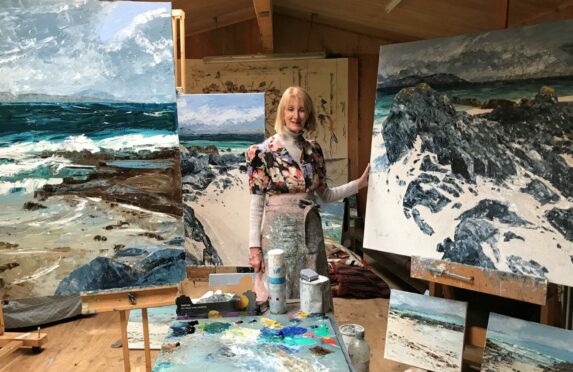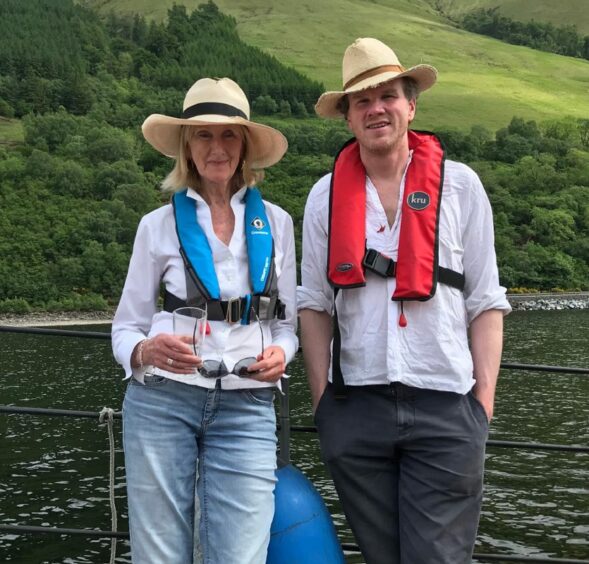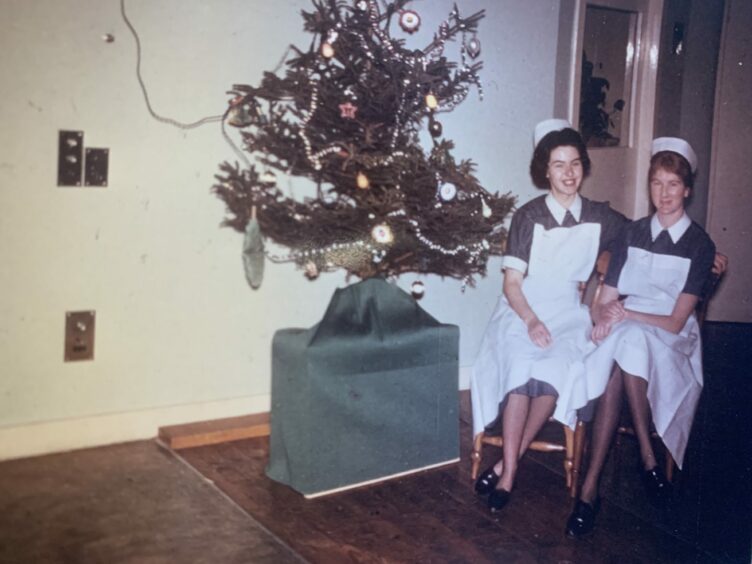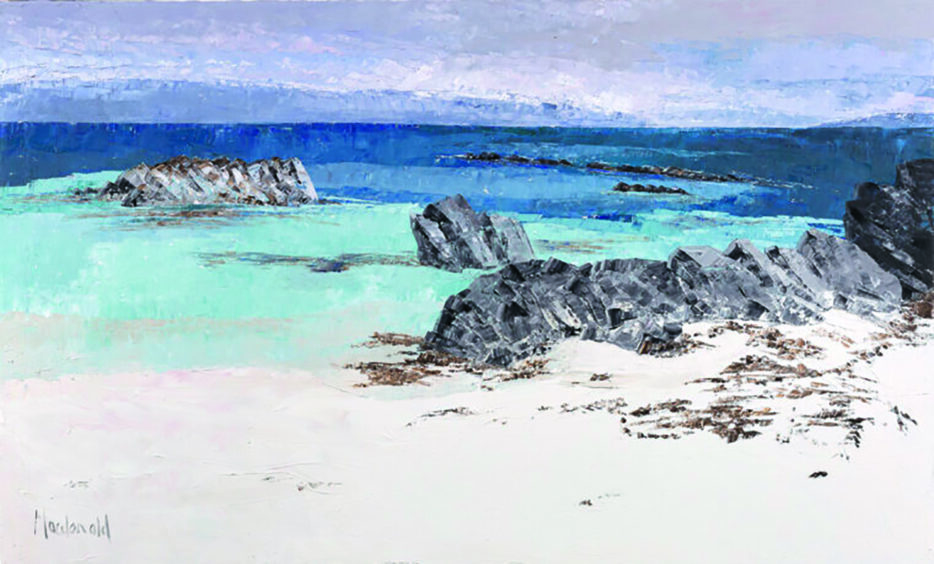
Frances Macdonald knows the warp and weft of the Argyll landscape like the back of her hand. She has been looking at it since she was a wee girl, playing on the shore around Tarbert, Loch Fyne, her home for the first six years of her life.
In 1970, Macdonald and husband Nick Ryan, moved to the west coast of Scotland as newlyweds to run the Crinan Hotel. In this beautiful spot, overlooking the famous Corryvreckan whirlpool, a narrow strait between the islands of Jura and Scarba, Macdonald began the process of intense looking. She went on to translate this into beautiful paintings of some of the country’s most stunning scenery.
Following in the footsteps of some of the great painters of Scotland’s dramatic west coast, such as Peploe and Cadell, Macdonald’s work now has a global fanbase.
In their five decades running the Crinan Hotel, the couple became known to the thousands of guests who arrived at this remote spot to be wined and dined in style. Celebrity visitors over the years included Sean Connery, Stephen Hawking, the Prada family, Princess Anne and Björk – to name but a few.
In between working and bringing up her children, Macdonald would paint. Now, following Ryan’s death in 2018 – and against the backdrop of Brexit and the pandemic – she runs the hotel single-handedly, still juggling a career as an artist with an international reputation. Not bad for a girl who didn’t go to art school because her banker father was worried she’d turn into a beatnik like her cousin.
Last week, a solo exhibition of her highly textured oil paintings – mostly views around Crinan as well as Iona, Staffa, Erraid and Kintyre – opened at The Scottish Gallery in Edinburgh. Many were reserved before the exhibition opened, fetching up to £16,000 for bigger canvases.
The Road To The Isles sees Macdonald at her brilliant best. With brio and energy, she carves out the intense yellows of lichen on rocks, the white-pink of sand on the beach against lime green sea grasses and the greeny-blues of the Atlantic waters.
Many of these views, she says, are imprinted on her mind’s eye and created from memory. Using her signature style of working quickly with a palette knife, she manages to make rocks, sea grasses and waves leap off the canvas.
As a youngster, Macdonald was a dab hand at drawing. “I’d be drawing rather than reading. Mostly animals when I was a child,” she recalls.
The family lived in Tarbert before moving to Greenock, where her father (a “frustrated architect”, according to his daughter) worked for the Union Bank. Young Frances attended primary school in Kilmacolm and then Greenock Academy.
“In my mind I was always going to art school,” she explains. “But cousin went to Edinburgh School of Art and got pregnant to some bearded fellow. My father probably thought I’d go off and be a beatnik, so he put the foot down and said it wasn’t happening. In those days, you listened to your parents, so I had to come up with an alternative career.
“I really wanted to travel. My grandmother on my mother’s side was from Oban and as a young widow had gone to sea, working on passenger ships. I decided nursing was a career which would allow me to travel, so I went to do my training at the old Royal Infirmary in Edinburgh. It was very much not the life of a beatnik!”
Macdonald’s career as a nurse took her to America, where she worked for a year in an operating theatre, and then on to passenger ships. But her creative passions never left her. During her training in the early ’60s, Macdonald was well known to colleagues as a talented artist. She sold her watercolour paintings of flowers for a few pounds to make some extra money.
Later, at sea, she painted scenes of places where the ship docked. She’d sell views of St Helena and Madeira to ship officers. “I always had an easel in my room,” she recalls. “It was tricky keeping the wet paint away from my white starched uniform!”
Macdonald continued to paint once she and Ryan moved to Argyll – mostly boats in the Crinan Canal basin and occasional landscapes.
The couple met and fell in love on board a Union Castle Line cruise ship. Macdonald was the ship’s “sister”, dealing with day-to-day medical issues and emergencies which befell the 500 passengers and 400 crew as they sailed from Southampton to Cape Town. Ryan was catering officer. “Nick used to keep appearing in my surgery,” she laughs.
“He soon ran out of vaccinations – and that’s how it all started. We got engaged on board the ship and married when we came back to Scotland. Nick got the job of running the Crinan Hotel and three other hotels. Within five days of getting married, we were living in Crinan. It was all very quick!”
A Family Affair: Mother and son join forces for first time during lockdown for gallery exhibition
Life got more and more busy, especially following the birth of their children, Julia and Ross. The couple ended up buying the hotel in 1977. Life wasn’t easy. Just over a year after they bought the hotel, it burnt to the ground. Its remote location meant that it took more than an hour for the fire brigade to reach the blazing building.
Undaunted, they decided to rebuild it and turned the hotel into a destination venue for fine dining, especially seafood, which was landed just yards from the rooftop restaurant. This hadn’t been done before and the hotel’s fame grew. Macdonald continued to paint. Guests would see her work hanging in the hotel and her paintings started to sell. She began submitting work to open exhibitions. By the ’80s, she was regularly showing with the likes of the Scottish Society of Women Artists and the Royal Glasgow Institute of the Fine Arts.
In the ’90s Macdonald started working in oils after her son Ross, then at art school, suggested it would suit her better than watercolours. “Of course, I’d never been to art school.” Macdonald laughs, “so I thought I’d impress him. I bought a three foot square canvas and did my first oil painting of Iona. I quickly realised that was not big enough, so I added another. It was done partly with a brush and partly with a palette knife.”
Macdonald would go on to make this technique of “sculpting” landscapes with a palette knife her signature style. “I was painting a lot of seascapes and to get the texture of the waves, it seemed the obvious way to do it,” she says.
McDonald cuts a stylish figure, the glamorous older lady artist. She resolutely refuses to divulge her age, though. “It’s become a family joke that I don’t say how old I am. But my daughter is 52 and my son is 47…”
Family is everything to Macdonald. Our conversation is peppered with references to Julia, a former model now studying literature at Edinburgh University, Ross, also a professional artist, and grandsons Archie and Jock, both students.
The big hole at the centre of all of their lives is the absence of Nick, a much-loved husband, father, grandfather, friend and gregarious hotel proprietor.
All Macdonald’s works in the new exhibition were painted following his death. This period also included the months of lockdown, during which the hotel was forced to shut its doors.
There are a few works which were painted with his memory in mind; particularly a little painting of Venice.
“Nick and I went to Venice in January several times. It’s a bit different from my usual scenes. I started looking at photographs of our Venice trips after Nick passed on. Painting is just what I do and I keep doing it. For me, it is an escape from everything I am thinking about. It keeps me going.”
For Frances Macdonald, life – and art – is all about being in the moment and catching it.
Portrait of the artist
Frances Macdonald’s ever-watchful eye captures every inch of land and sea during the changing seasons and weather patterns of the west coast.
Her late husband, Nick Ryan, was a keen sailor and now their artist son, Ross, is skipper of his father’s boat, Sgarbh, a 40ft classic motor vessel.
When the weather allows it, Ryan takes his mother out to Iona, Staffa and Erraid, or around Ronachan and Kintyre.
Macdonald’s vibrant use of colour is unmistakable and when she takes up her palette knife there is no stopping her painting the essence of this dramatic landscape.
Whether blue skies over flat, calm seas or squalling clouds above billowing waves, Macdonald sees and paints it all. No one paints yellow lichen like she does.
“Frances is so intimate with her part of Scotland,” says Christina Jansen, managing director of the Scottish Gallery. “She is not following in the footsteps of the Scottish Colourists, she is doing her own thing with her extraordinary colours. It is all about the landscape, the sea and the natural horizon.
“She pulls off running a hotel during a pandemic and after Brexit, with all the challenges that entails, with being an artist. Although she is always busy, her favourite pastime is being in the studio. Looking at her paintings will make you visit these places.”
The Road To The Isles, on now at The Scottish Gallery, Edinburgh

Enjoy the convenience of having The Sunday Post delivered as a digital ePaper straight to your smartphone, tablet or computer.
Subscribe for only £5.49 a month and enjoy all the benefits of the printed paper as a digital replica.
Subscribe

